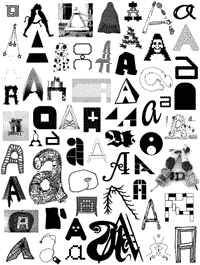What do DNA strands, rubber bands, dots, family crests, and plant life all have in common? They are all among the list of emerging logo design trends, as described in LogoLounge.com’s recently released report authored by Bill Gardner, “The 2007 Report: From Science to Sustainability, Logos Don’t Exist in a Vacuum“.
As the internet’s largest database of logos, with over 50,000 logos submitted to the site by professional designers, LogoLounge.com is certainly well-positioned to observe trends in logo design. So when LogoLounge released their recent report, featured in the April issue of GD USA Magazine, I took close notice. Scroll through the full report, with plenty of great examples of each trend cited and some insightful observations on the cultural forces behind these trends.
In addition to pointing out the increasing number of logos using such things as DNA helices, rubber bands, dots, radiant lighting effects, 3-D imagery and more, the report also shares some interesting observations on the way in which logo design, as a process, has changed recently. One of the most significant of these changes is the manner in which logo design “has become a public sport”. Gardner suggests that this somewhat disturbing trend is a result of the many ways in which media is increasingly controlled by the public through outlets such as Google, YouTube, TiVo, etc. “…people are no longer satisfied to simply consume what is placed before them.”, Gardner writes. “They have opinions they want to share. So when a large corporation reveals a new identity, there are hundreds of internet sites flinging their opinions back at it.”
Despite being a professional designer, I must admit that I don’t think this type of participation is entirely a bad thing. The fact that so many consumers are paying attention to the logo designs being presented to them on products is a good thing. In fact, it may be just the type of brand-involvement that so many companies are seeking these days. However, where the process goes awry is when this type of involvement turns into design-by-committee, design-by-public-opinion, or worse yet, design-by-contest. This type of crowdsourcing too often results of poorly conceived design, poorly executed design, or just plain poor design. In many cases, those involved in (re)designing the logo, or perhaps those commenting on the logo and suggesting alternatives, are unaware of the owner’s (i.e. the company’s) requirements for a good fit.
I’m not so egotistical as to suggest that logo design be left entirely to us professionals, and that brilliant logo designs could not be achieved at the hands of amateurs. History and common sense tell us otherwise. However, what I am suggesting, or rather emphatically stating, is that this type of trend is a slippery slope for everyone involved. Professional designers bring a level of understanding to both the process and the execution that typically elevates the end result (the logo) and allows it to function well across a variety of applications. Perhaps more importantly, experienced pro designers work closely with their clients to capture the image of the company and its message and enable the logo to accurately convey this message. This type of personal attention and designer-client communication is perhaps the real art behind logo design.





 The exhibit features the works of 48 designers and artists from North America, Europe, and Asia, ranging from well-known typographers and designers to up-and-coming artists and students. The work they display represents a variety of approaches to letters and a variety of styles ranging from “graceful and polished” to “witty and unconventional.”
The exhibit features the works of 48 designers and artists from North America, Europe, and Asia, ranging from well-known typographers and designers to up-and-coming artists and students. The work they display represents a variety of approaches to letters and a variety of styles ranging from “graceful and polished” to “witty and unconventional.” I believe that good design is inherently “green”, or at least to the greatest degree possible within any given project. Good design is based on the deliberate and thoughtful consideration of the client, the audience and their experience, and the context in which the project occurs. No consideration of the context can be complete without an examination of the social, cultural and environmental landscape and the impact the project might have. If a designer fails to take these steps, or chooses to ignore these concerns, they are not truly engaging in the practice of good design.
I believe that good design is inherently “green”, or at least to the greatest degree possible within any given project. Good design is based on the deliberate and thoughtful consideration of the client, the audience and their experience, and the context in which the project occurs. No consideration of the context can be complete without an examination of the social, cultural and environmental landscape and the impact the project might have. If a designer fails to take these steps, or chooses to ignore these concerns, they are not truly engaging in the practice of good design.